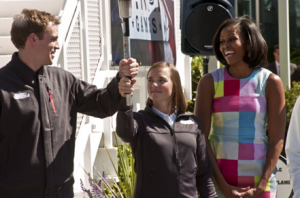
AW2 Soldier Justin Miller’s service dog “Dinah” gave him the companionship and encouragement he needed to move forward with his recovery and transition.
By Jeff Johnson, AW2 Advocate
AW2 Soldier Justin Miller was deployed to Iskandariyah, Iraq where he was injured on February 05, 2007 when he and his fellow Soldiers were subjected to a mortar attack that severely wounded him and his fellow Soldiers. Miller suffers from post traumatic stress disorder (PTSD). His involvement with a service dog is a story worth telling and can inspire others to take actions to address the challenges that PTSD places in their daily lives.
Miller struggled finding his way back from this incident. While taking pro-active actions to address his PTSD, he came in contact with Clear Path for Veterans, an organization in Chittenango, New York. Clear Path’s Dogs2Vet program assists Veterans by matching them with a rescue dog and trains the Veteran with the dog, creating a supportive bond that results in outstanding support to the Veteran and enhances their quality of life in the process. Following the training with the Veteran, the dog is certified as a service dog.
In the summer of 2012, Miller received his rescue dog “Dinah” a 3 year old, Black Lab which immediately provided Miller with what he calls “an emotional boost that really filled a void.” Miller and “Dinah” started a training program that involves about a year and a half of training between dog and Veteran. The training involves activities one to two times a week. Miller shared that the training not only enhanced his skills in working with “Dinah” but also skills in facing life’s challenges from his PTSD.
Clear Path for Veterans is a private, non for profit organization dedicated to helping military Veterans and their Families recover and reintegrate by offering a variety of support, training, vocational, and recreational programs in a rural setting of natural beauty. The organization offers many programs including outdoor activities, camping, vocational programs, and “talking circles” where Veterans can meet with each other and share their experiences and provide mutual support.
Miller shared that the biggest benefits for him were companionship and building his confidence to become more at ease and getting out socially with others. Another plus was learning how to show his emotions and get feedback on his emotions from others in a positive way. Miller takes “Dinah” with him just about all the time and will be brining her to college with him next semester.
From my experience with Miller, it is evident that Clear Path for Veterans Dogs2Vets program has been an instrumental factor in Miller moving on in his life; putting the pain of his injury behind him and assisting him to socialize with and support others who suffer the same injuries that he sustained in combat. Miller is currently studying to become a Recreational Therapist with a goal of assisting other Veterans.
Miller thinks that sharing his experiences will encourage other AW2 Soldiers who could benefit from a service dog to take the steps necessary to do the same as he has and enhance their life in a big way.








